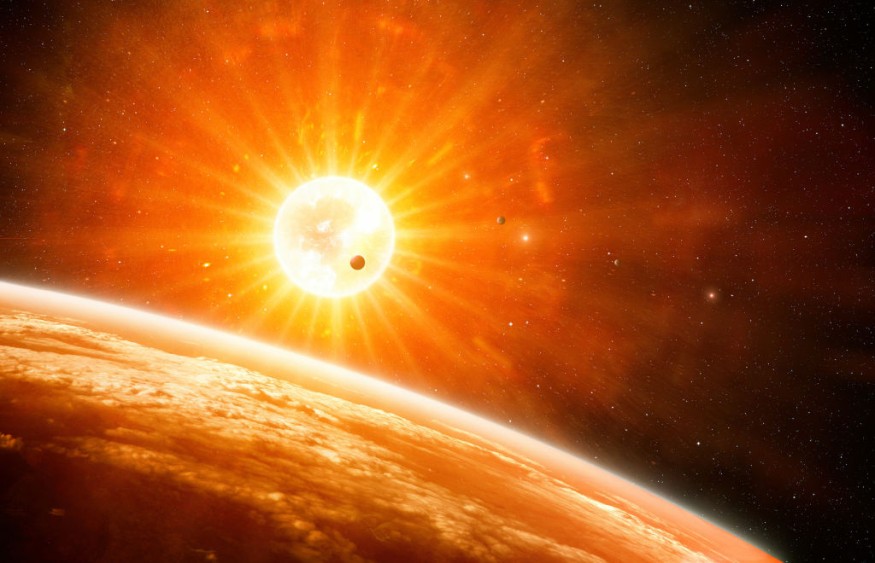Astronomers have recently made an unusual sighting of a pair of stellar spiraling to their doom by identifying the revealing signs of a teardrop-shaped star.
A Phys.org report specified that the tragic form results from an enormous nearby white dwarf deforming the star with its strong gravity, which will be the catalyst too, for an ultimate supernova "that will consume both".
Discovered by an international team of astrophysicists and astronomers led by the University of Warwick, it is one of only quite a few star systems, that has been found that will one day spot a white dwarf star reignite its core.
A new study has verified that the pair of stars are in their early stages of a spiral that will likely end in a "Type Ia supernova," type that is helping astronomers identify how fast the expansion of the universe is.

Spiraling Stars
The study received funding from the Deutsche Forschungsgemeinschaft, DFG, German Research Foundation, and the Science and Technology Facilities Council, part of the United Kingdom Research and Innovation.
Also called HD265435, this star is located approximately 1,500 light-years away and is composed of a hot subdwarf star and a white dwarf that orbit each other closely at a rate of roughly 100 minutes.
White dwarfs are 'dead stars' that have burnt out their entire fuel and collapsed in on themselves, making them tiny yet tremendously dense.
Meanwhile, la supernova is thought in general to have occurred when the core of a white dwarf star reignites, resulting in a thermonuclear explosion.
This report specified that there are two scenarios where such an occurrence can take place. In the first, the white dwarf is gaining adequate mass to reach 1.4 times the Sun's mass, called the Chandrasekhar limit.
The second scenario is where HD265435 fits, wherein the total mass of a close stellar system of multiple stars is close to or higher this limit.
Just a handful of other star systems have been found that will reach this threshold and lead to a Type la supernova.
Supernova Explosion
The University of Warwick Department of Physics' Dr. Ingrid Pelisoli, lead author of the study, "A hot subdwarf-white dwarf super-Chandrasekhar candidate supernova Ia progenitor", published in Nature Astronomy said, they do not know precisely how such supernovae are exploding although they know it needs to occur since it is seen taking place elsewhere in the universe.
Formerly affiliated with the University of Potsdam, Dr. Pelisoli explained, one way is if the white dwarf accretes enough mass from the hot subdwarf, so as the two of them orbit each other and getting closer, mater will begin escaping the hot subdwarf and fall onto the white dwarf.
According to a similar Science Codex report, another way, added the lead author, is that since they are losing energy to gravitational wave emissions, they will get nearer to each other until they merge. Once the white dwarf gets adequate mass from any of the two methods, it will go supernova.
Close Enough to Spiral Together
Through the use of the Transiting Exoplanet Survey or TESS of NASA, the research team was able to observe the hot subdwarf, but not the white dwarf, as the former is much brighter.
Nonetheless, the brightness varies over time, which suggested the star was being deformed into a "teardrop shape" by a massive object nearby.
With the radial velocity and rotational velocity measurements from the Palomar Observatory and the WM Keck Observatory, not to mention, by modeling the effect of the massive object on the hot subdwarf, the astronomers could confirm that the hidden white dwarf is as heavy as the sun, although just slightly tinier than the radius of the Earth.
In addition, combined with the mass of the hot subdwarf, which is slightly more than 0.6 times the mass of the Sun, both of the stars have the mass required to cause the Type la supernova.
As the two stars are already near enough to start spiraling together, the white dwarf will inevitably go supernova in roughly 70 million years.
Related report is shown on KHON2 News's YouTube video below:
Read also: Colossal Supernova Leftover Lying in Space: One-of-Its-Kind, Biggest Discovery in Astronomy
Check out more news and information on White Dwarf on Science Times.










